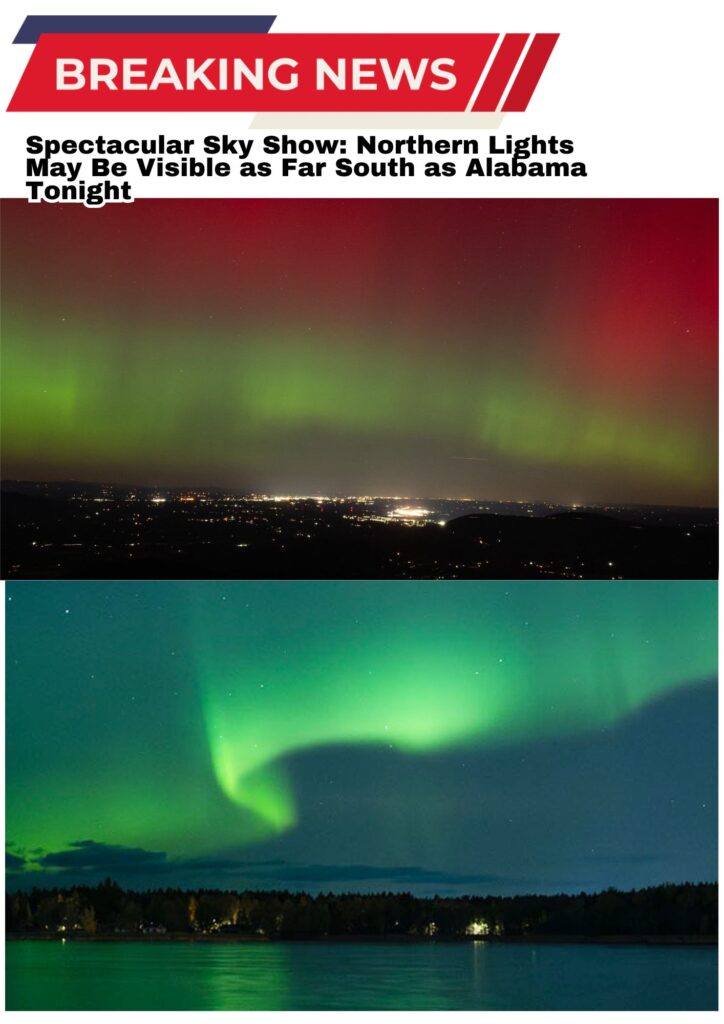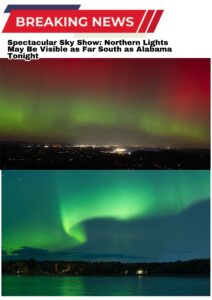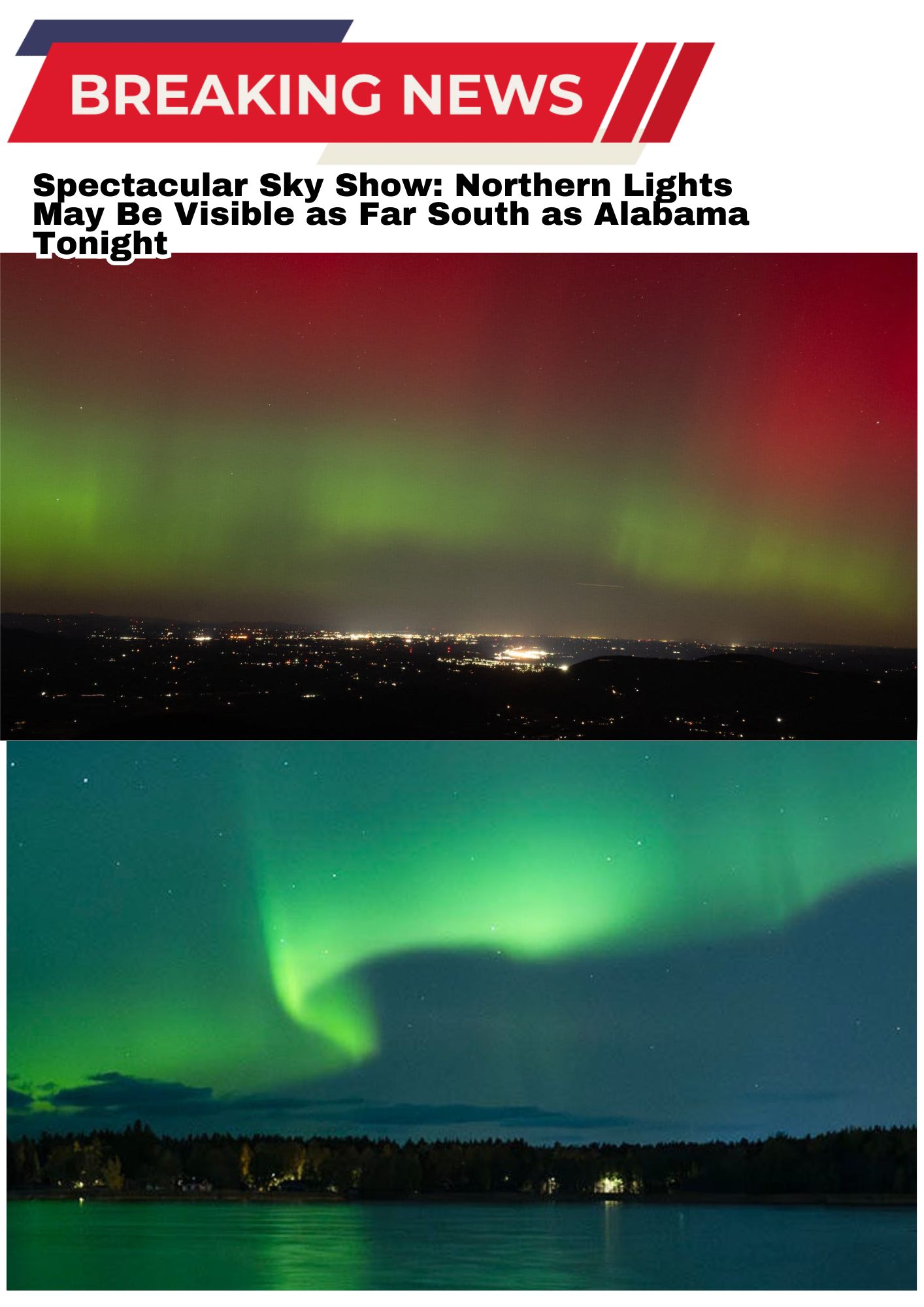Spectacular Sky Show: Northern Lights May Be Visible as Far South as Alabama Tonight
Spectacular Sky Show: Northern Lights May Be Visible as Far South as Alabama Tonight
Northern Lights Tonight: Aurora Borealis May Be Visible Across the U.S.
A rare geomagnetic storm may bring the northern lights as far south as Alabama and California. Learn when, where, and how to view this rare sky event.
Rare Auroral Display Expected Over the U.S.
A severe geomagnetic storm could treat skywatchers across the United States to a rare and breathtaking display of the aurora borealis, commonly known as the northern lights. According to the National Oceanic and Atmospheric Administration (NOAA), this event may allow people in regions as far south as Alabama, Northern California, and the Mid-Atlantic to witness the normally polar phenomenon.
The storm reached G4 severity early Sunday, June 1, 2025, intensifying the chances of aurora sightings in lower-latitude regions that rarely experience such events.
Viewing Opportunities Across the Nation
While the aurora is typically visible in northern states such as Minnesota, Washington, and Michigan, this storm is expected to push the visibility boundary far south. Areas that may catch a glimpse include:
- Northern California
- Oregon
- Nebraska
- Ohio
- Virginia
- Alabama
The best viewing will occur under dark, clear skies in locations away from urban light pollution. Areas in the Pacific Northwest, Midwest, and parts of the South may offer ideal visibility depending on weather conditions.
Best Time and Conditions for Viewing
The aurora is usually visible between 10 PM and 2 AM, though it may appear earlier or later depending on solar activity and local conditions. For the best experience:
- Head to a rural or elevated area with minimal light pollution.
- Find a location with an unobstructed view to the northern horizon.
- Dress warmly and prepare to stay for a while—auroras often come in waves.
Cloud cover will significantly impact visibility. Check local forecasts before heading out.
Why This Is Happening
The northern lights are caused by interactions between Earth’s magnetic field and charged particles from the sun. When these particles, carried by solar flares or coronal mass ejections (CMEs), enter Earth’s atmosphere, they collide with gas molecules and produce visible light.
The intensity of this storm—classified as G4 on a scale from G1 to G5—is due to a large burst of solar material that was ejected from the sun and directed toward Earth. While not expected to match the historic event of May 2024, it is still considered significant.
Will This Affect Technology?
Strong geomagnetic storms can impact certain systems. Potential effects include:
- Temporary disruptions in GPS and satellite communications
- Voltage irregularities in power grids
- Signal noise in high-frequency radio communications
At this time, NOAA has not reported any major technological impacts, but monitoring continues.
Tips for Photographing the Aurora
If you’re hoping to capture the northern lights with your camera or smartphone:
- Use night mode or long exposure settings.
- Stabilize your camera on a tripod or firm surface.
- Manually adjust ISO and focus for better clarity.
- Experiment with angles and exposure times to capture the full color spectrum.
Even if the aurora appears faint to the naked eye, your camera may detect more color and detail.
Track the Aurora in Real-Time
Stay informed with real-time updates using these reliable resources:
- NOAA Space Weather Prediction Center: www.swpc.noaa.gov
- Aurora Forecast Apps (for iOS and Android)
- Local weather channels and astronomy clubs
You can also check aurora forecasts that display live probability maps and KP-index levels, which help predict aurora strength and visibility in your area.
For many in the United States, tonight may offer a once-in-a-decade chance to witness the northern lights from home—no need to travel to the Arctic Circle. This event serves as a reminder of the powerful and beautiful forces at work in our solar system.
Make plans to step outside, check your local sky conditions, and look north. A stunning natural display may be waiting above the horizon.
Subscribe to our newsletter and follow us on our official social channels for real-time alerts on skywatching opportunities, extreme weather, and astronomy events.











Post Comment